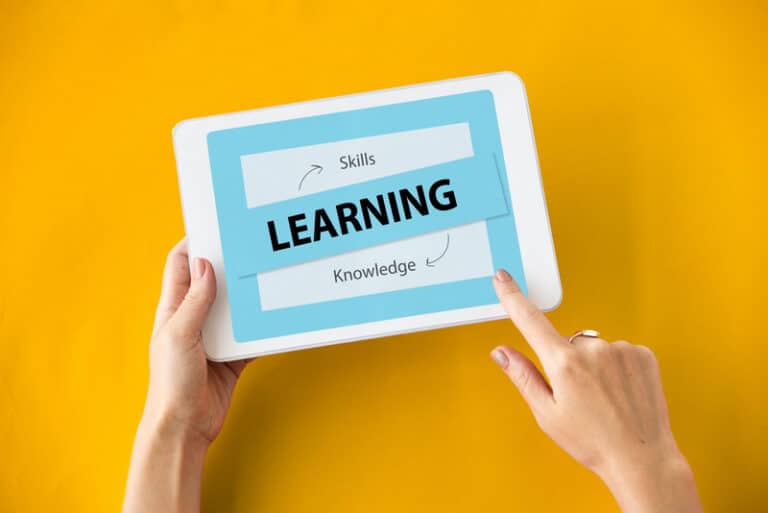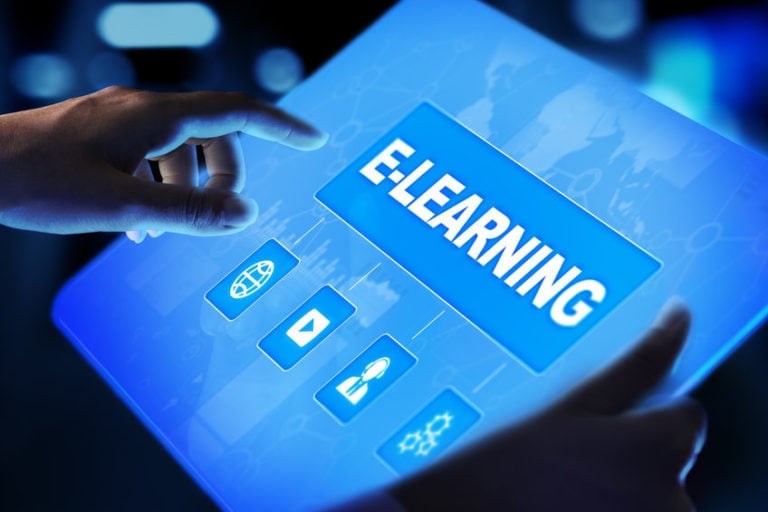Comparison of Webinars vs Podcasts vs e-Learning modules
What are key differences between a Webinar vs a Podcast vs an e-learning module? When choosing your training delivery formats, it’s difficult to know which to choose: a webinar vs podcast vs e-learning. It often depends on a variety of interactive factors. These include the demographics of your audience, development resources, desired delivery timeframes — and the expected lifespan of your production (online longevity).
This blog is 1 of 4 blogs in the Webinar vs e-Learning Comparison series. We’ve included a brief overview of podcast FAQs and pros and cons of webinars vs podcasts. By Connie May MHST. Be sure to review Part 2 – Development Comparisons of Webinars vs e-Learning: Cost differences and Delivery Pros and Cons as well as Part 3 (e-Learning Development) and Part 4 (Podcasts). (c) All Rights Reserved by PharmOut 2019-2020.
Key differences between Webinars, Podcasts and e-Learning courses
Should you choose a webinar, podcast or e-learning format?
The answer depends on your audience, your objectives, your conversion goals, and how much time, effort and money you have to spend on development and delivery.
Top Level Considerations
When comparing the PROs and CONs of webinars, podcasts and e-learning modules, you’ll need to take into account the following.
Audience / Learners (End-Users)
- User requirements (audience)
- Audience familiarity with technology
- Time zone differences
Presenters (Organisers/Hosts)
- Development costs
- Available resources including subject matter experts (SMEs)
- Time frames (conceptualisation to delivery)
Content (Complex)
- Reliance on stable internet speeds, bandwidth and technology
- Durability (digital longevity requirements)
- Data currency trends
Webinar Formats: Live or Pre-recorded?
Popular webinar formats fall into 2 main categories: ‘live’ or pre-recorded.
Live webinars
- A digital event that occurs at a set time
- Registration and log-ins are typically required
- Fees for hosting the event depend on the platform, duration (time length) and number of attendees
- Audience participation involves questions and answers (Q&A) during OR after the presentation
Pre-Recorded Webinars
- Recorded ‘live’
- Real-time events
- Presenter(s) and audience attend via an internet connection
- OR pre-recorded ‘Studio-format’ (no audience)
- Interactions limited to audience emails
- If a post-event webinar, original audience interactions may be seen
How much involvement does your presenter want with your audience? And can your audience attend the webinar event at the same time, or is scheduling an issue?
Live webinars depend on your audience being able to log-in and participate at a set date and time. This can deter overseas attendees from participating as your 3 pm webinar may mean 4 am in the morning their time.
Live webinar versions posted after the webinar may show the attending audiences’ participation in the form of questions (verbal or text formats are most common for webinar Q&A sessions).

Comparison of Webinars vs Podcasts vs e-Learning Modules
Which delivery format should you choose when deciding between a webinar, podcast or e-learning module?
After examining the key factors listed earlier, other aspects to consider include:
- Depth of content
- in-depth topics are best suited to online training courses
- long formats can be delivered in sequenced segments
- data that doesn’t require visual demonstrations can also be delivered via a podcast series
- Complexity
- Complex content best suits 24/7 delivery modes (e-learning delivery vs a podcast or webinar)
- Topics can be sequenced into smaller units (our online GMP training courses are a good example of this)
- Books (audiobooks) and podcasts can also be graduated (e.g., separate chapters), but miss out on visuals/graphics to help learners understand your data
- Webinars have scheduling limitations but do offer real-time questions and answers on topics that are typically confusing
- Interactivity / engagement
- Active learning (audience control over material delivery including pacing)
- Pacing is more audience-friendly on a recorded webinar or e-learning course rather than a LIVE webinar
- PAUSE and RESUME buttons come in handy on pre-recorded webinars
- Otherwise, a pressing matter may lead the attendee to miss half or more of your presentation
- Distractions and interruptions are expected
- Hence most webinars are posted online after the original event
- Time limits often apply for access after the event (from 24 hours to several weeks or months)
- E-learning participants can skip parts of the content that they already know but
- Webinars mean a participant needs to ‘sit through’ the entire webinar — including content they already know
- Retention by Review
- Retention typically declines over time
- Retention is facilitated by reviewing materials more than once, ideally not long after the original learning session
- It is easier to review content on a pre-recorded webinar, podcast or e-learning module vs a ‘live’ webinar which moves at the presenter’s pace
Exceptions: there are, however, numerous exceptions to interactivity differences between delivery formats.
For example, e-learning often offers more interactivity and self-directed pacing. But not all e-learning modules offer interactive learning experiences.
Additionally, live webinars may offer instantaneous audience interactions — and engagement — during delivery.
Questions and answers – text, live or pre-recorded?
Many webinar hosting platforms have question and answer capacity — this enables high levels of audience engagement.
Examples of customisable webinar settings including Q&A time: “raise hand” features, “use voice to ask a question” and/or “text message your question or comment to the presenter”
- Many webinars offer question-answer sessions
- These can be offered during and/or after the webinar presentation
- The presenter can control who has the microphone/floortime during question time — or which questions they respond to
- Some webinars offer no interactivity / zero question time
- Some webinars only allow follow-up questions by emails or phone calls (often used for marketing a product or service)
Development cost comparisons: webinars vs podcasts vs e-learning courses
- Development cost differences: e-learning has the highest development cost(s) compared to podcasts (excluding presenter and voiceover fees)
- Webinar development and hosting costs range from low cost to high cost
- Some webinars can be presented free of charge (small audience), especially if you have an expert presenter on hand who knows the material well
- If you need an actor or external SME for your webinar, that may involve higher development costs
- Factors impacting webinar hosting costs
- Platform fees/membership costs for webinar capacity
- Desired features and levels of customisation
- Live-recording and hosting features
- Digital longevity (future hosting), e.g. will the platform allow the webinar to stay live, online, for some time after it’s delivered?
Average costs of attending a Webinar

Cost of accessing information via a webinar (or podcast or e-learning module) can vary. Here’s a comparison of webinars vs podcasts vs e-learning data usage and general costings.
Most webinars are FREE to attend, but educational varieties can get expensive.
- Podcasts are often free but some are subscription-based (others are sponsored by advertisers)
- Many webinars and podcasts are offered free of charge especially if used for:
- brand-awareness
- service promotions
- lead generations
- Most e-learning is offered for a fee (education fees)
- these are lower than classroom learning
- low-cost e-learning is good for cutting training costs and for meeting average training budgets)
Platform differences and bandwidth comparing webinars to podcasts to e-learning
Your data plan and platforms, including software, influence your webinar, podcast or e-learning hosting costs.
- Platform costs, streaming fees and technology specifications
- E-learning requires higher costs for LMS/hosting and development
- E-learning requires software program licenses, LMS fees and instructional designers as well as SME access
- Data for podcasts is minimal compared to webinars and online courses, which are multi-media
- Webinar Participant Data use: Webinars often have heavy data-use, followed by e-learning data use, followed by podcasts (audio files are much smaller in size than multi-media formats)
- Internet bandwidth and data use intensity: large audiences require higher bandwidth (high-speed/uninterrupted internet access/data usage)
- Downloadability: podcasts use less data than webinars and e-learning; they are also the easiest to download and listen to at any time
Marketing your webinar to attendees is crucial for success.
Before you can get attendees to listen to your material, you need to consider the digital capacity of your desired audience.
- Is your audience computer savvy enough to engage with these formats?
- Do you, and your audience, both have the right equipment and internet bandwidth?
- Do you have a good way of communicating your event to your potential attendees?
Live webinars must also be promoted heavily, usually via paid advertising and organic social media promotions, if they are to be successful. Many webinars get far fewer attendees than the promoters would have liked.
It’s a competitive environment. Everyone’s offering free webinars these days. Make sure your webinar stands out. Keep your content tight, and your time frames reasonable. Remember, no one wants to sit on a webinar for more than 60 minutes. The trend for all digital formats continues to be shorter, tighter, more relevant curation of content.
Details and definitions: Webinars, Podcasts and e-Learning
Webinars vs Podcasts vs e-Learning: Content, Delivery and Cost Comparisons
Definition of a Webinar: A webinar typically involves a live video/audio streaming interaction between a presenter and registered Webinar attendees. Attendees can usually see and hear the presenter and/or the visual presentation media on their computing device (laptop, tablet or smartphone), using internet access and data.
- Webinars are essentially short informational sessions delivered remotely in a one-to-many format over the internet
- The average timeframe of a webinar delivery is usually 60 minutes (webinars range from 30 minutes to 120 minutes, with some webinars extending for several hours in duration)
- The webinar presenter may, or may not, be able to see or hear the attendees depending on the platform settings they have chosen
Webinar technology and resources: The technology required for hosting a webinar starts with creating a presentation and enlisting the help of a presenter (an industry expert or entertainer); plus access to one of the available video-conferencing platforms. Popular Webinar platforms offer custom delivery options, allowing the presenter full control over questions and microphones (participant interactivity) during the webinar presentation.
Be sure to review related content:
Part 2 – Development Comparisons of Webinars vs e-Learning: Cost differences and Delivery Pros and Cons
Part 3 (e-Learning Development)
Part 4 (Podcasts)
Webinar vs a Podcast (Comparison Summary): The key differences between a webinar, podcast and e-learning are related to development and hosting costs and time frames. Audio files are much easier to create, edit, post and host, followed by webinars. E-learning are the most complex courses to create, however, newer software applications and templates are easing online course development time burdens. Plus, e-learning courses are often digital assets that can be sold or distributed wider than a podcast and webinar, depending on your distribution plans.
Pros and Cons of Webinars vs E-Learning Training Courses
Last updated on October 7th, 2021 at 07:41 am






